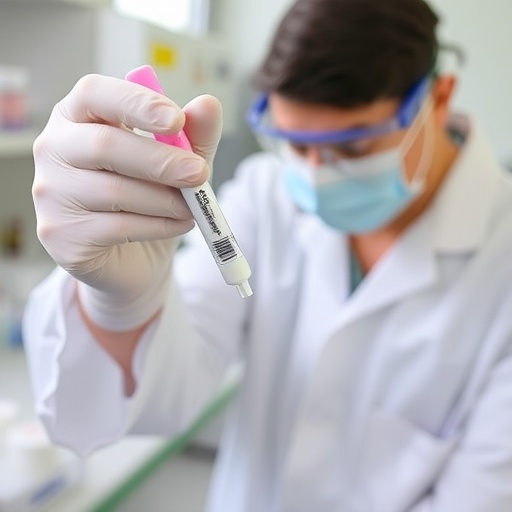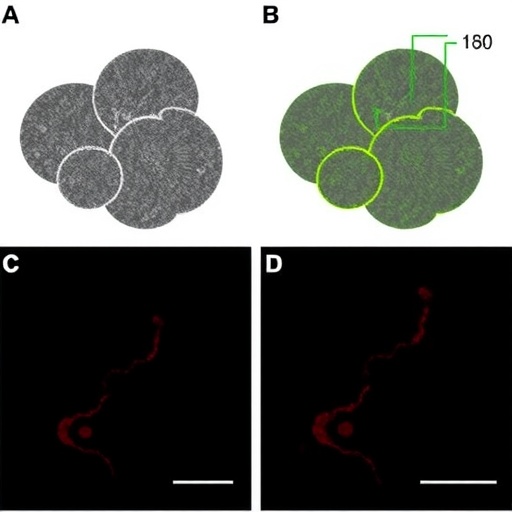In recent years, the field of molecular diagnostics has made significant strides, particularly in the detection and quantification of viral infections. Hepatitis B virus (HBV) remains a global health issue, impacting millions worldwide. The complexity of the virus and its interaction with host genomic material complicates the understanding of its pathogenicity and the management of HBV-related diseases. In this light, the development of a single-cell digital PCR method marks a groundbreaking advancement in the quantification of HBV DNA positive cells in liver biopsy tissues. This innovation promises not only to enhance diagnostic precision but also to facilitate a deeper understanding of HBV-related pathophysiology.
Single-cell digital PCR (scdPCR) is an evolving technology that allows for the amplification and quantification of DNA sequences at the level of individual cells. Unlike conventional bulk PCR techniques, which provide average results from a mixed population of cells, scdPCR demonstrates the potential to identify and quantify specific DNA molecules in discrete cellular environments. This ability to evaluate individual cells is particularly useful in studying heterogeneous populations of HBV-infected hepatocytes, the cells primarily targeted by HBV. By utilizing scdPCR, researchers can gain insights into the distribution and abundance of infected cells within the liver tissue.
The new methodology leverages the high sensitivity and specificity inherent in digital PCR. Digital PCR relies on partitioning the PCR reaction into thousands of individual reactions, allowing for the precise counting of target DNA molecules. This sensitivity is especially critical when monitoring low levels of HBV DNA, especially in patients undergoing treatment or those with chronic infections where virus levels can be intermittently low. The application of scdPCR in liver biopsy samples provides a powerful tool for clinicians and researchers alike, enabling more effective monitoring of viral load and assessing responses to antiviral therapies.
HBV’s ability to integrate its DNA into the host genome poses challenges for existing diagnostic methods, which often rely on bulk analysis and may overlook individual cellular dynamics. Traditional methods such as serological assays and nucleic acid tests can lack the resolution needed to analyze the complex interplay between HBV and hepatocytes. The introduction of scdPCR addresses this limitation by enabling the visualization and quantification of HBV-infected cells within the context of the liver microenvironment.
The impact of accurately measuring HBV DNA positive cells is multifaceted. Clinically, this technique can inform prognosis, as the quantity of infected cells may correlate with disease progression. Patients with high levels of HBV DNA-positive cells are at greater risk for developing liver complications, including cirrhosis and hepatocellular carcinoma. Therefore, precise quantification can assist healthcare providers in stratifying patient risk and tailoring treatment strategies accordingly.
Moreover, the scdPCR methodology holds promise for advancing research into the mechanisms of HBV pathogenesis. By isolating and quantifying infected cells, researchers can investigate the interactions between the virus and host immune responses. Understanding how HBV evades immune detection and establishes chronic infections is crucial for developing new therapeutic interventions, particularly as vaccine efforts continue to progress.
Additionally, the research led by Li et al. emphasizes the importance of refining biopsy sampling techniques. Biopsy remains the gold standard for liver disease diagnosis but can be invasive and carry risks. By integrating scdPCR, the need for larger sample sizes may be mitigated, potentially leading to less invasive approaches while still yielding reliable data regarding viral loads within liver tissues. This makes the prospect of obtaining liver samples more feasible for patients while still providing high-quality diagnostic information.
In the broader context, this method aligns with the innovative trends in personalized medicine. Personalized approaches to HBV treatment could harness the insights gained from scdPCR to tailor therapies for individuals based on their specific viral dynamics. Such strategies could improve treatment outcomes and enhance the overall management of chronic HBV infections.
As the study by Li et al. progresses, the potential applications and implications of scdPCR are vast. Researchers may extend this technology beyond HBV to other viral infections, thereby creating a versatile tool for infectious disease diagnostics across a wide range of pathogens. The advancement of single-cell technologies signals a new era in precision medicine, one where understanding individual viral load and cellular behavior can inform clinical practice more profoundly.
This novel single-cell approach also poses a challenge to the scientific community in terms of standardization and scalability. As the method gains traction, it will be essential for researchers to collaborate on establishing protocols to ensure reproducibility and accuracy across laboratories. Furthermore, a thorough validation of the technique will be necessary to confirm its reliability in broader clinical settings and among diverse patient populations.
In conclusion, the single-cell digital PCR method developed by Li et al. represents a significant leap forward in the fight against HBV. Its ability to quantify HBV DNA positive cells within liver tissues opens new avenues for research and clinical application, from understanding disease progression to refining treatment strategies. As the field of molecular diagnostics continues to evolve, innovations such as scdPCR will undoubtedly play a crucial role in enhancing our ability to tackle chronic viral infections effectively.
The implications for public health are profound. By enabling earlier and more accurate detection of HBV infections, scdPCR can contribute to better disease management and potentially reduce the burden of HBV-related illnesses worldwide. As we move towards an era where personalized medicine is at the forefront of medical advancements, incorporating state-of-the-art techniques like this will be imperative to ensure that patients receive the most effective care possible.
In summary, the innovative research presented by Li et al. underscores the potential for advancements in molecular diagnostics to transform our understanding and treatment of viral infections such as hepatitis B. The integration of cutting-edge technology like single-cell digital PCR into clinical practice heralds a new dawn in the fight against HBV, providing hope for improved outcomes for affected patients and paving the way for future breakthroughs in infectious disease management.
Subject of Research: Quantification of HBV DNA positive cells using single-cell digital PCR.
Article Title: A single-cell digital PCR method tailored for quantification of HBV DNA positive cells in liver biopsy tissues.
Article References:
Li, J., Li, H., Zhang, X. et al. A single-cell digital PCR method tailored for quantification of HBV DNA positive cells in liver biopsy tissues. J Transl Med 23, 1077 (2025). https://doi.org/10.1186/s12967-025-07131-9
Image Credits: AI Generated
DOI: 10.1186/s12967-025-07131-9
Keywords: HBV, digital PCR, liver biopsy, viral quantification, molecular diagnostics.
Tags: advancements in molecular diagnosticschallenges in HBV detection and managementhepatitis B virus quantification techniquesimplications of scdPCR in clinical researchinnovative PCR methods for infectious diseasesliver biopsy analysis for viral infectionsprecision diagnostics in viral diseasesquantification of HBV DNA in liver tissuessingle-cell analysis of infected hepatocytessingle-cell digital PCR for HBV detectiontargeted therapies for hepatitis B virusunderstanding HBV pathophysiology





